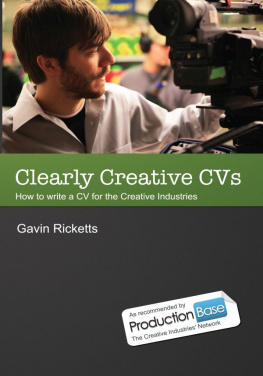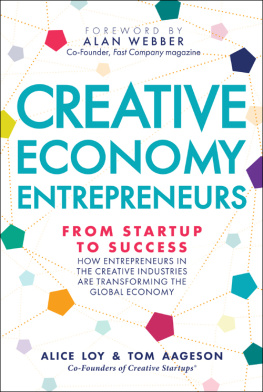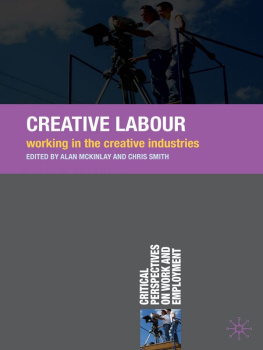Khaire - Culture and commerce : the value of entrepreneurship in creative industries
Here you can read online Khaire - Culture and commerce : the value of entrepreneurship in creative industries full text of the book (entire story) in english for free. Download pdf and epub, get meaning, cover and reviews about this ebook. year: 2018, publisher: Stanford Business Books, genre: Politics. Description of the work, (preface) as well as reviews are available. Best literature library LitArk.com created for fans of good reading and offers a wide selection of genres:
Romance novel
Science fiction
Adventure
Detective
Science
History
Home and family
Prose
Art
Politics
Computer
Non-fiction
Religion
Business
Children
Humor
Choose a favorite category and find really read worthwhile books. Enjoy immersion in the world of imagination, feel the emotions of the characters or learn something new for yourself, make an fascinating discovery.

Culture and commerce : the value of entrepreneurship in creative industries: summary, description and annotation
We offer to read an annotation, description, summary or preface (depends on what the author of the book "Culture and commerce : the value of entrepreneurship in creative industries" wrote himself). If you haven't found the necessary information about the book — write in the comments, we will try to find it.
Khaire: author's other books
Who wrote Culture and commerce : the value of entrepreneurship in creative industries? Find out the surname, the name of the author of the book and a list of all author's works by series.
Culture and commerce : the value of entrepreneurship in creative industries — read online for free the complete book (whole text) full work
Below is the text of the book, divided by pages. System saving the place of the last page read, allows you to conveniently read the book "Culture and commerce : the value of entrepreneurship in creative industries" online for free, without having to search again every time where you left off. Put a bookmark, and you can go to the page where you finished reading at any time.
Font size:
Interval:
Bookmark:
CULTURE AND COMMERCE
THE VALUE OF ENTREPRENEURSHIP IN CREATIVE INDUSTRIES
MUKTI KHAIRE
Stanford Business Books
An Imprint of Stanford University Press
Stanford, California
Stanford University Press
Stanford, California
2017 by the Board of Trustees of the Leland Stanford Junior University. All rights reserved.
No part of this book may be reproduced or transmitted in any form or by any means, electronic or mechanical, including photocopying and recording, or in any information storage or retrieval system without the prior written permission of Stanford University Press.
Special discounts for bulk quantities of Stanford Business Books are available to corporations, professional associations, and other organizations. For details and discount information, contact the special sales department of Stanford University Press. Tel: (650) 725-0820, Fax: (650) 725-3457
Printed in the United States of America on acid-free, archival-quality paper
Library of Congress Cataloging-in-Publication Data
Names: Khaire, Mukti, 1973 author.
Title: Culture and commerce : the value of entrepreneurship in creative industries / Mukti Khaire.
Description: Stanford, California : Stanford Business Books, an imprint of Stanford University Press, 2017. | Includes bibliographical references and index.
Identifiers: LCCN 2016048652 (print) | LCCN 2016050258 (ebook) | ISBN 9780804792219 (cloth : alk. paper) | ISBN 9781503603080 (e-book)
Subjects: LCSH: Cultural industries. | Entrepreneurship. | ArtsEconomic aspects. | ArtsMarketing.
Classification: LCC HD9999.C9472 K43 2017 (print) | LCC HD9999.C9472 (ebook) | DDC 658.4/21dc23
LC record available at https://lccn.loc.gov/2016048652
Typeset by Thompson Type in 10/14 Minion
CONTENTS
PREFACE
I begin this preface by discussing two television showsUnReal and Project Runwaya surprising choice given that I dont watch much reality television. However, the experiences I had with these shows nicely capture two main themes of the book, so, in the interests of introducing and motivating this book with some authenticity, I submit to the reader the following cases.
In the first example, my personal experience with the show UnReal, which premiered in June 2015, illustrates the importance of entitiescritics, reviewers, and the likethat seem peripheral because they do not produce the works that are consumed but are actually part and parcel of the creative industries. I had seen promotions for the new show on Lifetime TV while flipping through my cable providers on demand section. The font used in the advertisement; the way the title was presented; the title itself, which sounded like teen slang; and the fact that the show was aired on Lifetime TV, which I associated with cheesy, sentimental films, all put me off, and I paid no further attention to the advertisement. A few weeks after my initial dismissal, which was based on nothing other than gut instinct and evidence-free analysis (a classic situation of judging a book by its cover), I saw that Emily Nussbaum, the television critic for The New Yorker magazine had reviewed the show. I was surprisedthe show had not struck me as typical New Yorker material. Moreover, Nussbaum had praised the show. The very next evening, I watched every episode of UnReal that was available on demand. I liked the show; it had feminist sensibilities, as Nussbaum had written, but was also hugely entertaining and brilliantly acted, and it opened my eyes to the true extent of the unseemliness and fakeness in the world of reality television shows (such as The Bachelor), while also shedding light on the complexities of human nature that make reality television possible. Even though I didnt like every episode of the first season, I nevertheless watched the second season, which aired earlier this year, brushing aside any reservations I had, secure in the knowledge that Nussbaum, the television critic at The New Yorker, had endorsed the show. I discovered and even appreciated the show entirely because of Nussbaums review in The New Yorker.
The second example highlights the other main category of entities in the creative industries: the firms that actually engage in the production and sale of creative works such as books, films, music albums, television shows, and fashion apparel. These are the producers, and they are located at the intersection of art and business. Despite my research on the fashion industry and my particular interest in designers as founders of creative firms, I had never really watched the show Project Runway (on Bravo from 2004 to 2008 and then on Lifetime since 2009), which followed participants as they competed for the approval of a panel of judges comprising well-connected individuals in the fashion industry. It was never clear to me whether the judges on the show were looking for creativity (the next Alexander McQueen) or for commerciality (the next Ralph Lauren). It seemed to me that the show, and all other reality shows seeking the next talented individual, possessed a desire to be both arbiters of culture and promoters of commerce, a schizophrenic goal that was unlikely to be achieved to any substantial degree, let alone in full. I felt perversely vindicated then, on reading in The New York Times that Christian Siriano, the high-profile winner of the fourth season of Project Runway, had apparently not truly gained acceptance into the inner sanctum of the high-fashion world, despite having parlayed his win into a viable fashion line. The situation that Siriano found himself in was, I thought to myself, something I could have predicted, knowing that intangible, social assets do not always follow financial ones, although the reverse can and does happen. The so-called nouveau riche are familiar with this phenomenon, and anybody working in or observing the creative industries knows that greater status is accorded to the penurious artistic genius (writer, painter, sculptor, musician, filmmaker, and the like) than the creator of best sellers.
These two examples nicely preview the main themes of the book, which is about the nature, structure, and functioning of creative industries and how entrepreneurship in these industries can influence broader societal culture. As the examples above suggest, audiences are often suspicious or ignorant of new creative works until they are endorsed by critics/reviewers they trust. Thus producers in creative industries face the daunting task of having consumers discover and accept their product; in addition, producers constantly struggle to balance the cultural and commercial worlds that they must span to succeed as a commercial entity that sells cultural creations. These challenges raise some important questions: How and why does any entity (individual or organization) participate in these highly risky sectors of the economy, let alone introduce new products? How and why do consumers purchase cultural goods? What do critics stand to gain from introducing audiences to new works? This book attempts to address these and other relevant questions.
The Key Factors: The Art World, the Market World, and Entrepreneurship
Although my interest in the creative industries was originally spurred by a desire to understand the paradox of growth and scaling in commercial firms that are dependent on selling the work of a single founder (for example, high-fashion firms are founded to sell the creations of the founding designer), who presumably cannot create at the scale or speed of an automated process, I gradually became more interested in how the worlds of art and business coexist, interact, and even flourish in the context of creative industries. When I began to explore the topic in more detail, I found research that described an entire ecosystem of entities that needed to function together in a particular pattern of interactions, a situation that engendered stability. Because entrepreneurship is another area of my interest, I became intrigued by the entrepreneurial activity and artistic innovations that were occurring throughout the creative industries, stability notwithstanding, and how these activities affected both the creative industries and society more generally. This book is the result of my inquiries into the entities that populate the creative industriesartists, critics and reviewers, and producersand is informed by decades of prior academic work that addressed many of these questions from various angles. I integrate my empirical observations with prior scholarly work to derive conceptual frameworks and models that describe the system of entities, which I call the value chain, that constitutes the creative industries and facilitates the market exchange of cultural goods (the baseline case). In addition, I explore the implications of the nature and structure of the baseline case for entrepreneurship and new market creation. Underlying my interest in entrepreneurship is the belief that entrepreneurship that overcomes the stability of the creative industries and creates markets for radically innovative artistic goods, an act I label pioneer entrepreneurship, can have a profound impact on society and culture. I am aware that this last statementthat commerce can change cultureis likely to be controversial and therefore is worth interrogating at multiple levels.
Next pageFont size:
Interval:
Bookmark:
Similar books «Culture and commerce : the value of entrepreneurship in creative industries»
Look at similar books to Culture and commerce : the value of entrepreneurship in creative industries. We have selected literature similar in name and meaning in the hope of providing readers with more options to find new, interesting, not yet read works.
Discussion, reviews of the book Culture and commerce : the value of entrepreneurship in creative industries and just readers' own opinions. Leave your comments, write what you think about the work, its meaning or the main characters. Specify what exactly you liked and what you didn't like, and why you think so.



